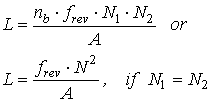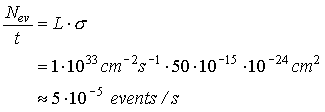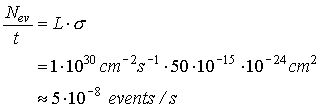by
Harri.Hakulinen@jnor.joensuu.fi
Exercise 1 Exercise 8 Exercise 2 Exercise 9 Exercise 3 Exercise 10 Background Exercise 4 Exercise 11 Exercise 5 Exercise 12 Exercise 6 Exercise 13 Exercise 7 Exercise 14
The
plan for the LHC is to use the LEP’s tunnel
to produce protons of very high energy.
a)
What is the maximum energy for a tunnel 27 km long with a maximum magnetic field
in the vacuum tube of 8.36 T.
According
to Newton II F = ma and when
the beam is a ring we get
![]()
and
the momentum of the beam particle is p = mv where m is the total mass on the particle.
So we get

The effective length of the
ring is less than 27 km, because the maximum energy is planned to be 7 TeV.
If the
energy of protons is 7 TeV, the
momentum of protons, according to Einstein, is given by
![]() and so
and so

or


There
are components other than the bending magnets in the ring, for instance,
accelerating cavities and focusing magnets.
The
percentage of the straight part in the accelerator is
![]()
In
the LHC ring there are 2835 bunches in each ring which will collide which each
other once in each detector. How many collisions of bunches are there in
a)
one second,
b)
one run which will last about 10 hours.
The
bunches travel at nearly the speed of light
so they meet every

so
the frequency of collisions is
![]()
It
should be 40 MHz, but there are some holes in the beam in other words some
bunches are missing. This is the reason for the pacman effect, that will be
eating the beam little by little, because those bunches that are not colliding
will behave in a strange way and somehow eat the other bunches or make more
holes to the beam.
And
in 10 hours there will be about
![]() .
.
The
data that will be collected from the collisions will about the amount of 10000
Britannica Encyclopedia per one second.
The
time interval between bunches arriving at one the detector is 25 ns. How many
collisions occur in one second and what is the rate at which the bunches meet in
the accelerator?
There
are
![]()
The
event rate that the bunches meet is then 40 MHz.
The
current of the proton particle beam in LHC
is 0.5 A. How many particles are there in one bunch if there are 2835
bunches in a ring and the time
interval between the bunches is 25 ns?
The
current is

The
time is 25 ns so we get
![]() .
.
What
is the total energy which is stored in the protons in one ring, when the protons
have the maximum energy 7 TeV and there are 1011 particles in
one bunch?
The
total energy in the beam is

If
you compare this to for instance to a boat which is traveling at the speed 3 m/s
which 11km/h, the mass of the “boat” should be

So
quite a big boat.
What
is the current if there are 1011particles
in one bunch?
The
current is
 or
or
![]() .
.
How
many turns can a proton beam stay vertically in the tube if you do not focus it?
The
diameter of the vacuum tube in LHC is 18 mm. From the kinematic equations we get
![]() and
the time is
and
the time is
 .
.
In
this time the proton will go
 turns.
turns.
The
beam should last 10 hours and therefore
![]() turns.
turns.
This
is why the accelerator must have some focusing components.
For
how long would Mika Hakkinen have to drive around the ring at a constant 320
km/h if he is to travel as far as a proton in LHC travels in one second.
It
will take
![]()
= 937,5 h = 39 days ( and nights).
In the LHC accelerator at CERN, the increase in current in the superconducting magnets can be 10 A per second. How long will it take to reach the maximum current of 11700 A?
The
time is
![]() .
.
The
basic element of the LHC is 15 m long and made of steel. How does the length of
the tube change when the tube is cooled to 1,9 K compared to the room
temperature 20oC?
The
event rate gives you information on how many events occur in head-on collisions
in the particle detector and is defined as
![]()
where
frev
is the how many times one bunches will go around the ring, N1 and N2 are the numbers
of particles in each bunch going in revert direction. A is the cross-sectional
area of the beam and s
is the cross section of a certain event (some sort of probability for a
certain event to happen). The first part is called the luminosity L and is
defined as

So
the event rate can be expressed as
![]() .
.
If
you know the frequency the bunches meet fbunch
the event rate is
![]()
The
luminosity of LEP was 100 ×
1030 cm-2s-1.
If the cross section of a certain event is 1.0 × 10-24 cm2 or one barn (b). How many
events will occur in one second ?
The
event rate in LEP when the cross section is 1 barn is

The
time for one revolution is

and
the frequency for revolution is
 .
.
There
are four bunches in a ring so the frequency between collisions is
![]()
and
the time interval between collisions is
![]() .
.
The
luminosity of LHC is in the beginning 1 × 1033
cm-2s-1. The estimated cross section to create a
Higgs boson to produce two g
is 50 fb. How many events do you
wait to see in one second ?
The
event rate is

You
should wait
![]()
until
one Higgs boson should appear.
In
Tevatron-accelerator in Chigago the
luminosity in the new machine is about 1030 cm-2s-1
. How long should you wait for Higgs in process where Higgs decays to two
photons if the cross section is the same. Tevatron has the maximum energy of
only 1 TeV and cross section depends on the energy so it is not quite true.
The
event rate is

You
should wait
![]() for the first Higgs and
for the first Higgs and
![]()
for
10 Higgs bosons to make sure that
it really is a Higgs boson.
They
start the experiment these days and the LHC will finished in 2006. So the race
to find Higgs will be tight.
If
the cross section for Higgs boson to produce top and antitop is 20 pb, so you
would expect
![]()
and
you should wait only 50 seconds.
The
luminosity of the LHC is 1 ×
1034 cm-2s-1.
If there are 17000 events in 100 ms, what is the cross section in barns of this
event ?
The
event rate is
![]()
so
the cross section of the event is

The
cross section of a reaction to produce the Z-particle, one of the weak
interaction carriers, in LEP where the collision happened between electrons and
positrons, is 32 nbarn at the beam energy 91 GeV. How long did they have to wait
for the first event if the luminosity was 23×1030cm-2s-1?
The
event rate is
 .
.
So
time was approximately 1/(0,736 1/s) =
1,4 s when the first Z-particle was
made out of energy.
There
are three kinds of particles which are made of quarks. The mesons which are made
of a quark and an antiquark (qq), baryons which are made of three quarks
(qqq) and antibaryons which are made of three antiquarks (qqq).
Only particles made of these combinations have been found.
The
theorists assign a color to each quark (red, blue or green) and their anticolor
to the antiquarks to explain the above combinations of quarks. The rule is that
all particles are white and a particle is white when the quarks inside the
particle have 3 different colors or one color and its anticolor.
Another
rule is that nobody has seen a particle which does not have an integer charge.
The charge must be –1, 0, +1 or +2 because the quark’s charge is either +2/3
or –1/3. For instance three times +2/3 is +2
or (+2/3) + (-1/3) + (-1/3) is zero or three times –1/3 is
–1.
|
Quark |
Short
name |
Charge/e |
|
up |
u |
+2/3 |
|
down |
d |
-1/3 |
|
strange |
s |
-1/3 |
|
charm |
c |
+2/3 |
|
bottom |
b |
-1/3 |
|
top |
t |
+2/3 |
In
the standard model how many ground state (spin = 0) mesons and baryons could
there exist if we
had
a)
4 quarks (u, d, s and c) or
b)
6 quarks
(see the table below).
When
you calculate the charge of the particles in part b) it could be useful to organize the quarks on the following
way:
|
Quark |
Charge/e |
|
u |
+2/3 |
|
c |
+2/3 |
|
t |
+2/3 |
|
d |
-1/3 |
|
s |
-1/3 |
|
b |
-1/3 |
First
we deal with quark and antiquark (q,aq) so mesons.
|
u
+2/3 |
d
-1/3 |
s
-1/3 |
c
+2/ 3 |
|
au
-2/3 |
ad
+1/3 |
as
+1/3 |
ac
-2/ 3 |
Charge
can be either zero, plus one or minus one.
Each
quark can be with two antiquarks to produce no charge so there are
4
×
2 = 8 possibilities. When the charge is +1 or –1 there are two possibilities
for each quark so 8 and so 16 different mesons altogether with 4 quarks.
You
can do in the same way, when you have six quarks.
|
u
+2/3 |
d
-1/3 |
s
-1/3 |
c
+2/ 3 |
b
–1/3 |
t
+2/3 |
|
au
-2/3 |
ad
+1/3 |
as
+1/3 |
ac
-2/ 3 |
ab
+1/3 |
at
–2/3 |
You
can combine each quark with three others to get zero charge when there are six
quarks so there could be 6 ×
3 = 18 different particles.
The
final charge is –1 or +1 there are also three possible antiquarks for each
quark and so there are 6 ×
3 = 18 different possibilities. So there are 36 different mesons when you have 6
quarks in use.
There
is also another way. We put all quarks in a table as below.
|
|
au -2/3 |
ad +1/3 |
as +1/3 |
ac -2/3 |
ab +1/3 |
at -2/3 |
|
u
+2/3 |
u,au
0 |
and |
so |
on |
|
|
|
d
-1/3 |
d,au
-1 |
|
|
|
|
|
|
s
-1/3 |
s,au
-1 |
|
|
|
|
|
|
c
+2/3 |
c,au
0 |
|
|
|
|
|
|
b
-1/3 |
b,au
-1 |
|
|
|
|
|
|
t
+2/3 |
t,au
0 |
|
|
|
|
|
In
this way we 6 ×
6 = 36 different mesons on ground state (spin = 0).
First
we look at the three quark (qqq) - combinations.
First
the baryons which have no charge (Q = 0). Every quark with charge +2/3 can
connect to another with charge –1/3 in
six ways. For instance quark u to
dd, ds, ss, st, tt, dt so 6 ways to do it. And the other c and b also, which
have a charge +2/3. We have 18
different particles.
|
Quark |
Charge/e |
|
u |
+2/3 |
|
c |
+2/3 |
|
t |
+2/3 |
|
d |
-1/3 |
|
s |
-1/3 |
|
b |
-1/3 |
Next
the baryons with charge –1. The quarks from the lower part of the table will
connect to each other in 3×3×3
ways and we get 27 different particles.
The
same when the charge is +2 (the
upper part of the table). They can connect to each other on 3×3×3
= 27 different ways and we get 27 particles more.
Last
is the charge +1 and it is similar to when the charge is zero. You take one
particle from the lower part of the table (Q = -1/3) and connect it to two
particles from the upper part (Q = +2/3)
Altogether there will be 18 + 27 + 27 + 18 = 90 different particles called baryons. There are also antiparticles so get 90 particles more and the total number of different baryons is 180. This the case when the baryons are in their ground state where they have the minimum energy. The mixed states and the exited states of quarks are also individual particles and are not included in here.